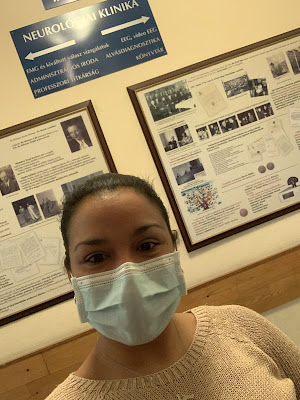Neurology final exam experience
 |
| Post-exam selfie! |
The exam was scheduled to start at 10:30 am. Around this time, the secretary welcomed all the English Program students into the Department Library for us to leave our bags and jackets. We wore our white coats and were led to the ward. We sat outside the patient rooms and waited for a resident doctor to come to start the physical neurological examination. When he came, he welcomed the first student into the patient room. The student exited the room and the doctor called for the next student. I stood up, walked towards the door, sanitised my hands, and put on gloves. I entered the patient room and introduced myself to the doctor and the patient.
The resident asked me the following,
1. Show me how to examine the muscle tone in the lower limbs.
Doctor: What are two types?
Me: Spasticity and rigidity.
Doctor: How do we tell the difference between the two?
Me: Spasticity is elicited with fast movements and is only felt in one direction either flexion or extension, while rigidity is elicited by slow movements and can be felt in both directions.
Doctor: In what disease do patients present with rigidity?
Me: Parkinson's disease.
2. Show me how to examine the pupillary reflex.
Doctor: If we don't see a reaction in both eyes, where is the lesion?
Me: In the nerve.
Doctor: You mean oculomotor nerve?
Me: Yes.
3. What are the pyramidal signs?
Me: Hoffmann, Trömner, Babinski...
Doctor: Show me how to examine the Babinski reflex.
4. What are the components of the epicritic sensation?
Me: Two-point discrimination, fine touch, vibration.
5. What are the signs of upper motor neuron lesions?
Me: Normotrophy then hypertrophy, pyramidal signs, hypertonia...
Doctor: And areflexia or hyperreflexia?
Me: Hyperreflexia.
He handed me a paper and told me to go back downstairs. In the library, I chose my three topics for the theoretical exam. I pulled,
2. Drug-induced movement disorders
3. Treatment of Traumatic Brain Injuries
I grabbed some paper and sat down to write out my topics.
The student that had his patient exam before me was ready with his topics and started first, while the rest of us continued writing. After him, it was my turn. I headed to the Professor's office. The examiner was Prof. Komoly, he and another doctor were sitting waiting. I sat down, introduced myself and began to present my first topic, Ultrasound.
Me: There are 4 different types of ultrasound. The first one I will talk about is 2D (B mode) ultrasound. Echoes reflected from structures are plotted on the oscilloscope screen in 2D. The resulting brightness at each point reflects the density of the structure. Blood does not reflect sound, therefore the lumen appears as black. The vessel wall and atherosclerotic plaques can be seen.
Professor: Okay, have you heard of peripheral vascular ultrasound? It is the most important thing here and most textbooks don't mention it.
Me: No, I wasn't aware.
Professor: Next topic...
Next, I talked about Drug-induced Movement Disorders. I said everything on my paper. When I finished, the doctor had some questions,
Professor: If you have a 30-50-year-old patient that presents for the first time with a tremor. What disease are you thinking of?
Me: Maybe early-onset Parkinson's disease.
Professor: Think genetic. Autosomal recessive.
Me: Wilson's disease.
Professor: When the patient presents and you suspect it is Wilson's what is the first thing you are going to do to diagnose it?
Me: Slit-lamp examination to check for Kayser-Fleischer rings.
Professor: Yes. Why is it so important we diagnose Wilson's disease?
Me: Because it's treatable.
Professor: And how can we treat it?
Me: D-penicillamine, liver transplant.
Professor: Yes, we have to do a liver transplant if we do not catch it in time. But usually, if we catch it early on and start medication patients can live normal lives. Last topic...
I finished with Treatment of Traumatic Brain Injuries. I said all that I had written, then the doctor asked,
Professor: What are some bleeding brain injuries?
Me: Epidural haemorrhage, subdural haemorrhage, and subarachnoid haemorrhage.
Professor: And contusion.
Me: Yes.
He looked at the assistant and asked if she had any questions, she said no and my exam was over.
Professor: It is excellent.
Another one done!
 |
| These are what my notes from the exam look like. |

Comments
Post a Comment